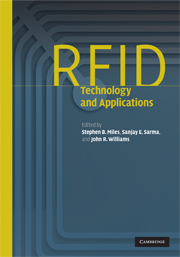Book contents
- Frontmatter
- Contents
- List of contributors
- Preface
- Acknowledgments
- 1 Introduction to RFID history and markets
- 2 RFID technology and its applications
- 3 RFID tag performance optimization: a chip perspective
- 4 Resolution and integration of HF and UHF
- 5 Integrating sensors and actuators into RFID tags
- 6 Performance evaluation of WiFi RFID localization technologies
- 7 Modeling supply chain network traffic
- 8 Deployment considerations for active RFID systems
- 9 RFID in the retail supply chain: issues and opportunities
- 10 Reducing barriers to ID system adoption in the aerospace industry: the aerospace ID technologies program
- 11 The cold chain
- 12 The application of RFID as anti-counterfeiting technique: issues and opportunities
- 13 Closing product information loops with product-embedded information devices: RFID technology and applications, models and metrics
- 14 Moving from RFID to autonomous cooperating logistic processes
- 15 Conclusions
- Appendix – links to RFID technology and applications resources
- Editor biographies
- Index
- References
11 - The cold chain
Published online by Cambridge University Press: 02 November 2009
- Frontmatter
- Contents
- List of contributors
- Preface
- Acknowledgments
- 1 Introduction to RFID history and markets
- 2 RFID technology and its applications
- 3 RFID tag performance optimization: a chip perspective
- 4 Resolution and integration of HF and UHF
- 5 Integrating sensors and actuators into RFID tags
- 6 Performance evaluation of WiFi RFID localization technologies
- 7 Modeling supply chain network traffic
- 8 Deployment considerations for active RFID systems
- 9 RFID in the retail supply chain: issues and opportunities
- 10 Reducing barriers to ID system adoption in the aerospace industry: the aerospace ID technologies program
- 11 The cold chain
- 12 The application of RFID as anti-counterfeiting technique: issues and opportunities
- 13 Closing product information loops with product-embedded information devices: RFID technology and applications, models and metrics
- 14 Moving from RFID to autonomous cooperating logistic processes
- 15 Conclusions
- Appendix – links to RFID technology and applications resources
- Editor biographies
- Index
- References
Summary
The cold chain is a concept resulting from the field of the transformation and distribution of temperature-sensitive products. It refers to the need to control the temperature in order to prevent the growth of micro-organisms and deterioration of biological products during processing, storage, and distribution. The cold chain includes all segments of the transfer of food from the producer to the consumer. Each stage crossed by a temperature-sensitive product is related to the preceding one and has an impact on the following one. Thus, when a link of this “cold chain” fails, it inevitably results in a loss of quality and revenue, and, in many cases, leads to spoilage.
The cold chain concept can also be applied to many other industries (pharmaceuticals, dangerous goods, electronics, artifacts, etc.) that require the transport of products needing to be kept within a precise temperature range, in particular at temperatures close to 0 °C, or even below [1]. Owing to very strict rules from government agencies the expression “cold chain” has even become one of the key sentences at the heart of current concerns in the pharmaceutical field and in biotechnology [2].
The food industry
Temperature is the characteristic of the post-harvest environment that has the greatest impact on the storage life of perishable food products. In some regions of the globe, especially in tropical and subtropical regions, post-harvest losses of horticultural crops are estimated to be more than 50% of the production due to poor post-harvest handling techniques such as bad temperature management.
- Type
- Chapter
- Information
- RFID Technology and Applications , pp. 144 - 156Publisher: Cambridge University PressPrint publication year: 2008
References
- 15
- Cited by



